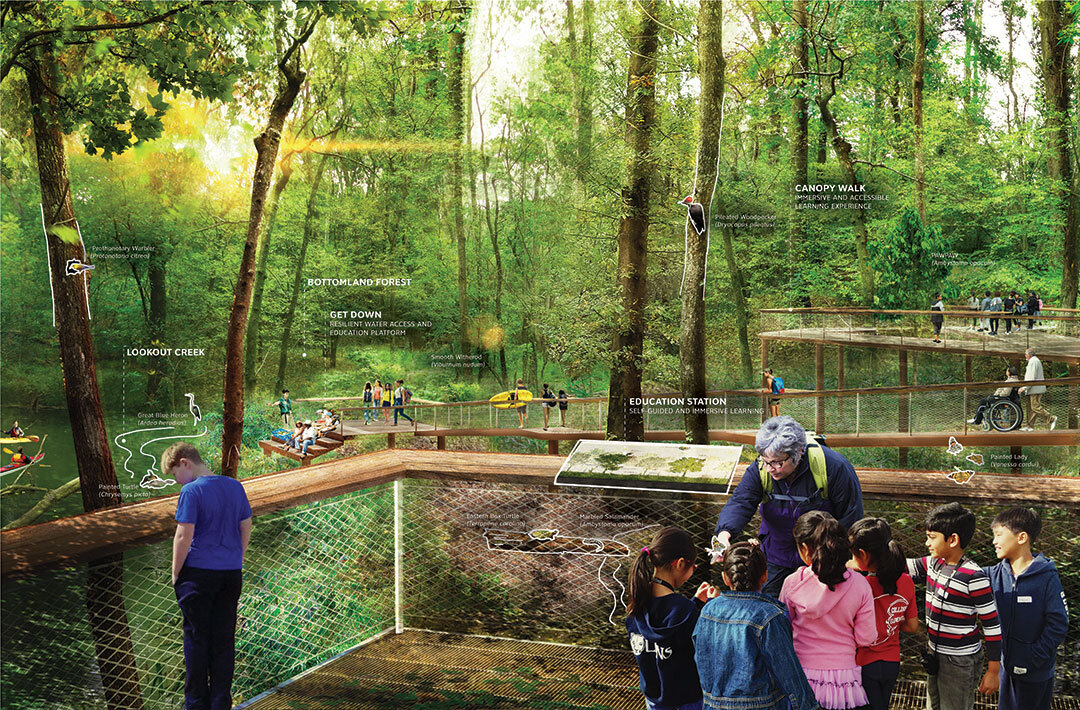Emerald Ash Borer Impacts our Campus
The Emerald Ash Borer Impacts Our Campus
As you can see in this photograph, our boardwalk has been constantly threatened by falling ash trees. Our Framework for the Future anticipated issues like this, and the solutions we designed in that process will build resilience in the future. We envision a canopy walk experience lifted out of the floodway that would be available year-round for visitors. We need your ongoing support as we continue to move toward the future we would like to see.
The good news? Currently, our canoes, dock, and boat launch are now back open! The Paddler’s Perch remains closed. If you want to help repair the boardwalk, please check out our volunteer page and let us know! We have invested thousands of dollars to restore access, but even this step will be temporary (5-10 years) because of the flooding caused by the increased frequency and intensity of storms in our area.
A few years ago, the Emerald Ash Borer Beetle (Agrilus planipennis) came to Southeast Tennessee and killed most of the ash trees in the area. This invasive and destructive beetle is native to Asia and came to the US in wooden packing materials in 2002. Soon after that, the beetle began to impact and kill ash trees in the US. More recently, you may have noticed that ash trees impacted by the beetle regularly fall across the region and on our entire campus. To learn more about this threat and the tremendous impact it's having, check out the USDA’s Emerald Ash Borer Beetle page.
Our Land Conservation team is working through the many challenges the Ash Borer brought. You may have noticed damage to the boardwalk, treehouse, and paddler’s perch as the dead ash trees fall. Our team decided to stop investing in the materials and labor needed to repair these areas, as they will likely be destroyed again quickly as other dead ash trees fall. Instead, our team is working with expert arborists on a plan to remove the ash trees. To complicate matters further, the ash trees are in the middle of a swamp, so solutions are more complex. We wish it were as simple as driving a truck up and cutting the dead trees down!
Reflection Riding works closely with the American Battlefield Trust, which owns a property adjacent to ours with easy creek access. We have asked for permission to access the creek from their property by walking through our Nature PlayScape area and down the slope to the creek from there. We think this temporary solution will allow creek access for our members who love to paddle until we can get the dead ash trees in the swamp out. We’ll keep you posted as we work through the legal details to make this happen.
Our plan to remove the dead ash trees and restore creek access is a stopgap. As you have probably noticed, the swamp floods most of the winter and spring (and sometimes at other times of the year), and the assets there—paddler’s perch, the boardwalk, canoe access—will continue to be at risk. Our Framework for the Future considers the relationship between our entire campus and Lookout Creek, the surrounding National Park Service land, and our larger social context. Our Steering Committee designed the Framework to make our campus more resilient in the face of more frequent and intense storms and flooding. We invite you to support Reflection Riding as we embrace the challenges and opportunities the future will bring.
We envision a future experience in the wetland that elevates most walkways out of the floodplain but still offers seasonal access to the creek. It might look something like this! Learn more on our Framework for the Future page.



